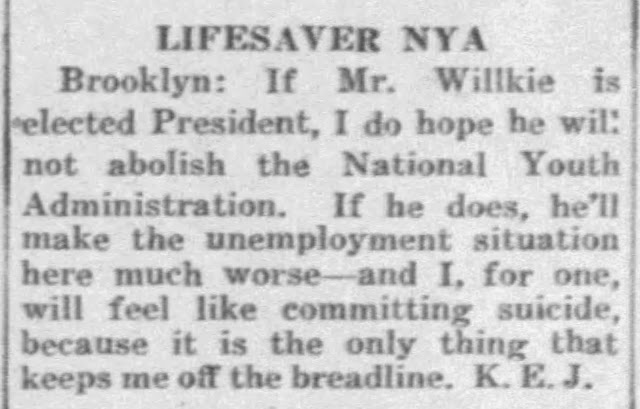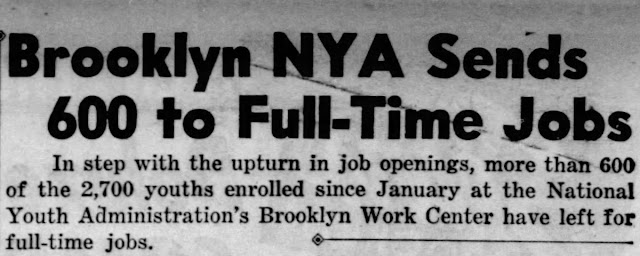
Above: A Brooklyn Bridge breadline, early 1930s. Unknown photographer, photo courtesy of the Library of Congress.
Above: Part of an article from the Times Union (Brooklyn, New York), December 27, 1933, p. 10. During the winter of 1933-1934, the New Deal's Civil Works Administration (CWA), employed over 4 million jobless Americans. Image from newspapers.com, used here for educational and non-commercial purposes.

Above: "Waterfront--Brooklyn," an oil painting by Harry Shokler (1896-1978), created while he was in the New Deal's Public Works of Art Project (PWAP), 1933-1934. The final report of the PWAP shows Shokler living at 11 Columbia Street... and so he may have seen this exact scene right from his home. Image courtesy of the Smithsonian American Art Museum.

Above: A graphic from the final report of the Work Division of the Federal Emergency Relief Administration (FERA), highlighting the diversity of work it facilitated. In this 1934-1935 report, we learn that "In Brooklyn, N.Y., a 400-foot tunnel under one of the busiest streets, over the subway roof and under water and gas mains, has been constructed to connect the modern heating system of the new Municipal Building with the Hall of Records, the Borough Hall and the Supreme Court Building, which has been so inadequately heated by antiquated methods as to endanger the health of employees" (p. 80).

Above: A 1936 photograph of the Lefferts House in Prospect Park, Brooklyn, New York, taken for the Historic American Buildings Survey (HABS). The National Park Service explains that "HABS was just one of many cultural programs initiated during President Franklin D. Roosevelt's 'New Deal' administration... The individual state 'surveys' were funded through both the Civil Works Administration (CWA) and the Works Progress Administration (WPA)..." Photo by E.P. MacFarland and provided courtesy of the Library of Congress.

Above: The library building at Brooklyn College, 1936, one of several buildings at the college that were funded by the PWA. Photo courtesy of the National Archives.
Above: "Paper Boquet," a painting by Joseph P. Pandolfini (1906-1987), created while he was in the WPA's Federal Art Project, ca. 1935. Pandolfini had also worked in the New Deal's Public Works of Art Project (PWAP), and the final report of the PWAP showed him living in Brooklyn at 6605 18th Avenue. According to the Genesee Valley Council on the Arts, Pandolfini taught painting at the Brooklyn Museum. Image courtesy of the General Services Administration.

Above: From the Brooklyn Citizen, December 2, 1936, p. 14. Image from newspapers.com, used here for educational and non-commercial purposes.

Above: The caption for this photo, taken ca. 1935-1939, reads: "Floyd Bennet Airport, Brooklyn, New York - Field house, between hangar 5 and administration building." Note the WPA sign on the building. Photo courtesy of the National Archives.

Above: The caption for this WPA photo, taken ca. 1935-1938, reads: "Entrance to one of the group of buildings composing the new Zoo in Prospect Park, Brooklyn, N.Y. From excavation to roofing, including the artwork, the buildings were constructed and equipped entirely by work relief program labor. Brooklyn now has one of the most modern zoos in the country." Photo courtesy of the National Archives.

Above: "Fulton Street, Brooklyn," an artwork by Ann Nooney (1900-1970), created while she was in the WPA's Federal Art Project, ca. 1935-1939. Image courtesy of the General Services Administration.

Above: A WPA poster, advertising a free music performance by the WPA's Federal Music Project, ca. 1935-1939, at 912 Union Street, Brooklyn, New York. Image courtesy of the Library of Congress.

Above: Part of an article from The Brooklyn Daily Eagle, May 2, 1941, p. 19, reporting on an upcoming WPA music event at Prospect Park, featuring pianist Grace Castagnetta (1909-1996). Image from newspapers.com, used here for educational and non-commercial purposes.
Above: Part of an article from the Daily News (New York, New York), July 13, 1941, highlighting the success of the National Youth Administration's Brooklyn Work Center. The work center was located at 980 Atlantic Avenue. Image from newspapers.com, used here for educational and non-commercial purposes.

Above: NYA enrollees at the Brooklyn Work Center, 1941 (from the newspaper article cited in the previous caption). Image from newspapers.com, used here for educational and non-commercial purposes.

Above: A Brooklyn writer to the Daily News (New York, New York), July 12, 1940, fearing that a Wendell Wilkie presidency might mean the end of the National Youth Administration, which in turn might lead the writer to suicide. Image from newspapers.com, used here for educational and non-commercial purposes.





No comments:
Post a Comment